INTRODUCTION
We often think of history as a book that happened a certain way because that’s how it was supposed to happen. We think that because something turned out one way, that’s the only way it could have turned out and there was nothing that could have been done to change this. But that’s not true. Think about this week. How many of the things that happened had to happen, and how many were because of choices that people made? Natural disasters, like earthquakes cannot be stopped, but choices by government leaders and the latest social trends are because of human choices.
When we study the Cold War, we should think about how much of what happened was because of the choices people made. The Cold War split the world in two and really messed up a lot of people’s lives. And it lasted for more than 40 years. When the Cold War started, could people have made better choices so that things didn’t have to turn out so badly? If they could have, why didn’t they? Why didn’t they just stop the Cold War from starting?
Of course, sometimes things get out of control, and there is nothing that people can do to stop bad things from happening. If this was true with the Cold War, what got out of control? What were the things that caused the Cold War that were too powerful for people to stop? These are the questions that we will ask as we start studying the Cold War.
As World War II was ending, it seemed like the whole world was turned up-side down. Things were not the way they had been before World War II, and people were trying to figure it all out. Could government leaders, military leaders and everyday people have made different choices than they did that could have kept the Cold War between the East and the West from starting? Or was the Cold War going to happen anyway?
COMMUNISM AND CAPITALISM
The basic problem in the Cold War was that there were two different ideas about how the world should work. It was not a war about religion, in the way that Hitler had hated of Jews in the Holocaust. It was not a war about raw materials and power, like the Spanish-American War. And it was not really about who had charge of land, like the Indian Wars of the late 1800s.
The Cold War was a competition to control how people would live their lives in different parts of the world. The two competing ideas were the free market economic system and communism. These two ideas were not new. Actually, the struggle between the people who liked these ideas had been going on for years and years.
In the United States we have a free market economic system. This is sometimes called capitalism. In a capitalist system, all of your choices are free, but everything costs money, or capital. For example, you are free to choose what to buy, where to buy it, and how much to spend. Of course, you have to pay for what you buy. Also, the store owner can choose what to make and sell, and how much to charge for what he or she sells. The owners can also decide who to hire to work for them, and how much they are willing to pay their workers. No one makes the workers take a job, and they can quit if they want to. It is their choice. We call capitalism a free market economy because everyone is free to make whatever choices he or she wants. Notice that in a free market economy the government does not have to run things.
Capitalism may be simple because no one has to plan it, but it is not perfect. Some people will come up with very good ideas, or they work hard and make a lot of money. And some people who are lazy, or just have bad luck, will end up being poor. In a free market world, there are classes of people. The upper classes own businesses and have control over most of the money, and the middle and lower classes do the work for the upper class.
Communism is different in every way. In the 1800s, two German thinkers, Karl Marx and Friedrich Engels, saw how millions of people were having a hard time because they worked every day in factories and only got paid a tiny amount of money. But the factories were owned by a few rich men who had so much money they couldn’t even spend it all. Marx and Engels were sure they knew a better, more fair way to make the world work. In 1848, they wrote their ideas down into a short book and called it “The Communist Manifesto.”
Marx and Engels thought that the money of the world should be shared by the workers who made that wealth possible. Farmers should share the money earned for the food they grew. Factory workers should get some of the money earned from the goods they made. Businesses would have no owners, only workers. Marx and Engels said that if their ideas were put into practice no one would be poor. Anyone who wanted a job and was willing to work could have a job. The things and the food that the people produced would be shared by all the people who worked. Marx, Engels, and those who thought as they did had a saying: “From everyone according to his ability, to everyone according to his need.” In other words, everyone would do their best at whatever they were best at for the good of the country, and everyone would share the country’s wealth.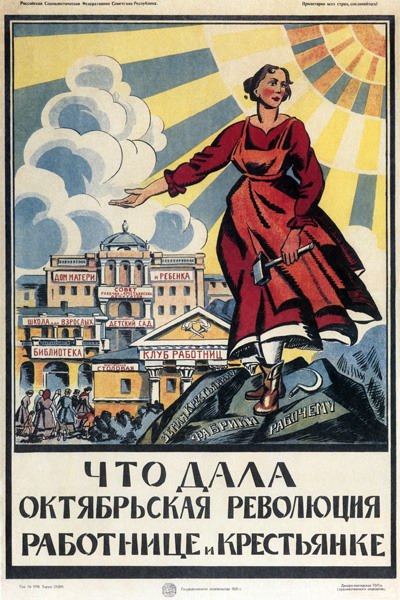 Primary Source: Document
Primary Source: Document
Propaganda, such as this poster from the Soviet Union, was common in the communist world. Advertising is a sign of a free market economy. So, instead, the Soviet government used propaganda to urge the people to work hard for the good of the country.
Communism sounded like a good idea, but in the real world people with money — the upper classes — used their money to try to get the people who ran the government to do what they wanted done. They did not like communist ideas. Imagine how John D. Rockefeller or Andrew Carnegie must have felt about communism! Marx and Engels had followers in both Europe and the United States. The International Workers of the World, a union that wanted to start a communist revolution in America, tried to get the working classes to throw out the government in America. Of course, many people were against them. Often called the “Wobblies,” their top leader, Frank Little, was murdered. In the United States people were so afraid of communism that in the years after the First World War the government passed laws to stop immigration so that people from Europe who might like the idea of communism would not be able to get into the United States.
However, in Russia in 1917, things turned out differently. Millions of poor farmers hated the king, or Czar of Russia, Nicolas II. Russia was losing to Germany in World War I and Russians were ready for a change. Vladimir Lenin and his followers, called Bolsheviks, took this chance to take power away from the Czar, and created the world’s first communist country. To show that Russia would now be a communist country, they changed its name to the Union of Soviet Socialist Republics (USSR), or the Soviet Union for short.
 Primary Source: Photograph
Primary Source: Photograph
Vladimir Lenin led the successful revolution in Russia in 1917 and established the Soviet Union as the world’s first communist nation.
When Lenin died in 1924, the person who was second in charge took power. The new Soviet leader was Josef Stalin, a cruel man who locked up and killed many thousands of the people of the USSR. In many ways, Stalin was just as terrible as Hitler, but during World War II the United States was at war with Hitler’s Germany and so was Stalin’s Soviet Union, which made the United States and the Soviets allies. Being on the same side, however, did not make the Soviets or the Americans think any better of each other’s ideas about communism or capitalism.
Americans had seen what communism was like in the real world. Lenin, Stalin and the Soviet leaders had taken away what people owned. They had forced millions of people to give up their land, and moved thousands of people to work on farms and in factories run by the government. They arrested or killed people who spoke out against the government. Communism was not the perfect system that Marx and Engels had promised. Americans did not want to become a communist country. They also did not want anyone else in the world to have to live in a communist country.
PLANNING THE POST-WAR WORLD
President Franklin D. Roosevelt first became president in 1932 when the Great Depression was at its worst. His New Deal programs had made him so popular that Americans elected him a total of four times. Near the end of World War II Roosevelt was in his fourth term as President. One of the most important things he did was to go to meetings with leaders of the other allied countries. These meetings were so that the Allies could plan how to fight the Axis Powers. By 1945, everyone could see that the Allies were winning the war, so the Allied leaders met to plan for the future. After all of the terrible damage done by the war, what kind of future world would they build?
At the Yalta Conference in February of 1945, President Roosevelt, Prime Minister Winston Churchill of the United Kingdom, and the Soviet Union’s Josef Stalin met. Roosevelt wanted the Soviets to help America fight Japan in the Pacific. Roosevelt also wanted Stalin to agree to join a new United Nations. Churchill wanted fair elections and democratic governments in Eastern and Central Europe. But Stalin wanted to see communists take over the governments of those countries. He thought that having communist countries around the Soviet Union would help protect his country from another attack in the future.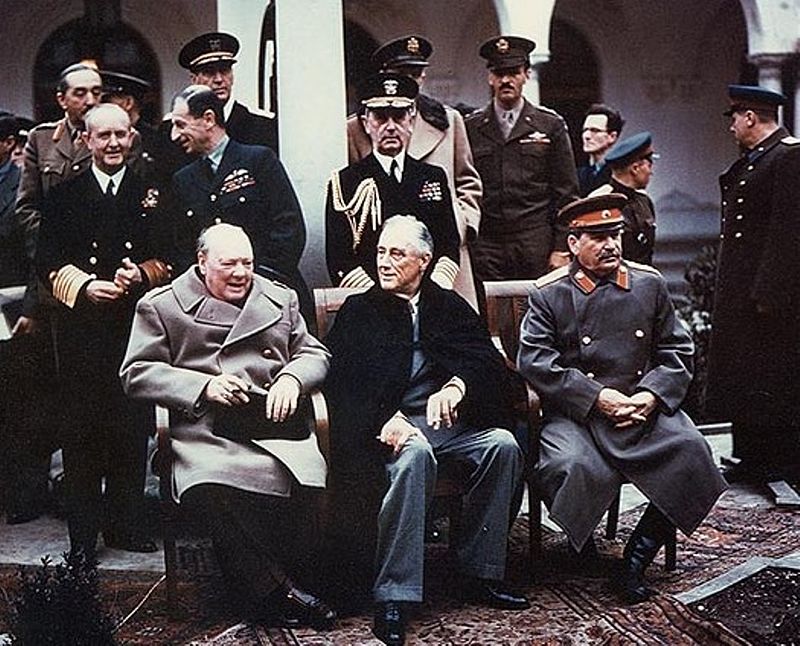 Primary Source: Photograph
Primary Source: Photograph
Churchill, Roosevelt and Stalin at the Yalta Conference
Not long after the Yalta Conference, on March 29, 1945, President Roosevelt died from a stroke. People in America and around the world were shocked and very sad. They did not know that Roosevelt was not healthy.
When the Allied leaders met again in July of 1945, the war in Europe was over. Germany had surrendered and Hitler was dead. America’s new president, Harry Truman was about to use the nuclear bomb to end the war with Japan. The choices the leaders made at the Potsdam Conference would change the map of Europe, especially for Germany.
The leaders agreed that the Soviet Union would have control over Eastern Europe just like Stalin had wanted. This included the countries of Poland, Czechoslovakia, Hungary, Romania, Albania, and Bulgaria. Germany would be split into four areas. The Soviet Union, the United Kingdom, the United States and France would each control one of the areas. Germany’s capital city, Berlin, was inside of the Soviet area, or zone, but it too would be split up into four zones. In the years that followed, the western allies joined their zones together to make West Germany and the city of West Berlin. The Soviet Union, however, set up communist governments in each of the countries they had beaten in the war and created East Germany and the city of East Berlin.
DECOLONIZATION
Like Europe, the rest of the world also saw big changes. Since the 1800s, large areas of Africa and Asia had been run as colonies by the great countries of Europe. During the twenty years after World War II, most of these colonies asked for, fought for, or were given independence in a process called decolonization. India won its independence from the United Kingdom in 1947 under the great leader Mahatma Gandhi. In Africa, many new countries were created. The same thing happened in the Middle East. It was there that Jews from Europe who lived through the Holocaust created the new country of Israel in the land talked about in the Bible.
Most of the old colonies were very poor. For years and years the people of Europe had taken oil, minerals, diamonds, and rubber from their colonies and given almost nothing back. Europeans hadn’t spent money to make their colonies better. For example, in the Congo, a colony of 13 million people, only 16 people had a college degree when it won its independence from Belgium in 1965. Without educated people, many of these new countries had a very hard time setting up governments that could run large countries and manage their rich natural resources.
Both the United States and the Soviet Union were interested in the future of this new, free Third World. The Soviets thought that they could spread communism there. Americans believed that these new countries could only be free if the spread of communism was stopped. Both superpowers, the US and the Soviet Union, also wanted to be able to get the natural resources of the Third World.
 Secondary Source: Map
Secondary Source: Map
These new nations in Africa and South and Southeast Asia plus nations in the Middle East and Central and South America, are known as the Third World.
THE UNITED NATIONS
In 1918, the United States had decided not to join the League of Nations, and that world organization had not been strong enough to stop Germany and Japan from starting World War II. In 1945, many leaders thought that a stronger international organization was needed to stop wars from starting.
Even though the Soviet Union and the United States had different ideas about how governments should run, the idea of countries around the world working together was an important result of World War II. Along with other things, this was because people realized that each country trying to go it alone had failed. So this new spirit of working together led to the birth of the United Nations (UN) in 1945, with its main office in New York City.
The United Nations has different groups with different jobs. One is the Security Council, which is the executive branch of the United Nations. The Security Council must say okay to any action that the UN takes, such as economic sanctions, the use of military force, or the use of soldiers to keep the peace in times of war.
The five countries that won World War II, the United States, Great Britain, France, China, and the Soviet Union (now Russia) each hold a seat on the Security Council that cannot be taken away. Ten more seats are held by other countries. They are chosen by the UN General Assembly every two years. The five permanent members hold the power of veto. No action can take place unless all five agree. During the Cold War, the veto power of the United States and the Soviet Union often kept the Security Council from taking strong action when difficult and important decisions needed to be made.
The main body of the United Nations is the General Assembly. Every country holds a seat in the General Assembly. The General Assembly has the power to give advice to the Security Council, but has no power to make the Security Council do anything.
The United Nations has a Secretary General who is chosen by the Security Council. He or she runs the day-to-day activities of the UN. The United Nations charter does not say exactly what the Secretary General should do, but the people who have been Secretary General often try to help countries find peaceful solutions to their problems and to fight for human rights. It is a custom that the Secretary General is never from one of the five permanent member countries. The Secretary Generals over the past sixty years have come from countries like Norway, Peru, South Korea, Thailand, Egypt, Ghana and Spain.
The UN does other things too. It has an International Court of Justice, and it helps women and children, and people who have to leave their own country because of wars. It also works to end disease and the problem of not enough food in the world. For example, UNICEF and the World Health Organization were started by the UN.
After his death, Franklin Roosevelt’s wife Eleanor wanted the United Nations to write an International Declaration of Human Rights. Even though it has been broken many times, the declaration that she helped to write is a noble goal for each country to try to follow.
The old League of Nations failed, but the United Nations is still around today and has done many good things, including helping to keep the peace in areas where there is war, fighting disease and helping more people in the Third World learn to read.
In 1945, and today as well, the United Nations gives us hope that countries in the world can get along together. The UN is far from perfect, but it does give a way for nations to live together in peace for the good of all people.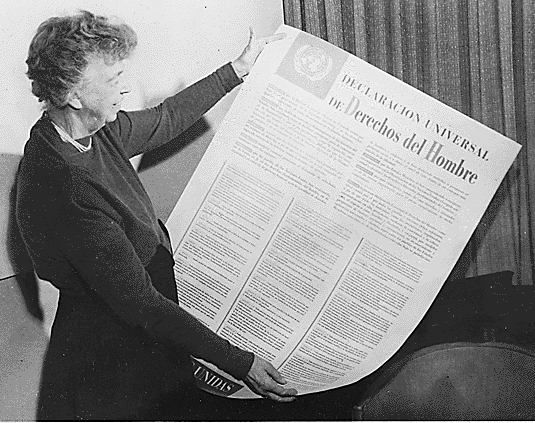 Primary Source: Photograph
Primary Source: Photograph
Eleanor Roosevelt holding a copy of the Universal Declaration of Human Rights, her most famous work as a humanitarian.
THE IRON CURTAIN
In 1946, Winston Churchill gave a speech about how Europe and the world was starting to be divided between capitalism and communism. In the speech he said, “From Stettin in the Baltic to Trieste in the Adriatic an Iron Curtain has descended across the continent. Behind that line lie all the capitals of the ancient states of Central and Eastern Europe. Warsaw, Berlin, Prague, Vienna, Budapest, Belgrade, Bucharest and Sofia; all these famous cities and the populations around them lie in what I must call the Soviet sphere, and all are subject, in one form or another, not only to Soviet influence but to a very high and in some cases increasing measure of control from Moscow.”
The Iron Curtain that Churchill talked about was both a real border and a border that a person felt in their mind: a border between the East and the West-between freedom and communism. Fences, guards with guns, and especially the Berlin Wall, clearly showed how divided the world was during the Cold War.
The location of the Iron Curtain was a result of how World War II ended. In the places the Americans and the British took back from Germany during the war, they helped set up new governments that had elected leaders and capitalism. This included France, Belgium, the Netherlands, and Italy. This worked well because the people of those countries saw that the Allies had saved them from Germany, and they did not need the Allied countries to lead them.
Germany was different. There was no question that the Allies were going to stay in Germany to build it again themselves. As Truman and Stalin had planned at their meeting in Potsdam, the division of Germany into East and West was a way to share this very difficult work. This plan gave Stalin a chance to help the small German communist party take over in East Germany.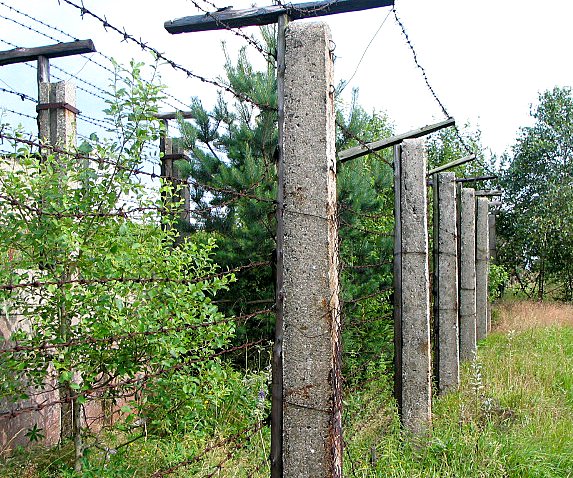 Primary Source: Photograph
Primary Source: Photograph
In most of Europe, the border between East and West was marked by fences and border guards.
It was the same way all across eastern Europe. In the countries that the Soviets had taken back from Germany, the communists took over the governments. These countries included Poland, Czechoslovakia, Romania, Albania, Hungary, Bulgaria and East Germany. The Soviet Army made the economies of these countries work like the Soviet Union. Private people did not own farms, or factories where things were made, or businesses. These were all owned and run by the government.
Although the Iron Curtain was a divide in the way people thought about their governments and economies, in some places you could see it. It was also the fences and soldiers along the borders between the East and the West, especially in what was called the “inner German border” between East and West Germany. Outside of the cities, there were fences. In the cities, high concrete walls were built. In the first ten years after the war people could easily travel between the East and the West. But by the end of the 1950s, that was almost impossible. After the Berlin Wall was built in 1961, people from the East were shot and killed by their own border guards if they tried to escape into the West. Primary Source: Photograph
Primary Source: Photograph
The Berlin Wall being built in 1961. Eventually there would be two walls with a wide space in between them to make it more difficult for people to escape from East Berlin.
The division between the communist countries and the non-countries during the Cold War could also be found in Asia, but the words “Iron Curtain” were usually only used for the border in Europe.
The Iron Curtain was a real border of concrete and steel and soldiers. But even more so, it was a border in the minds of people. It was like a screen that hangs halfway across a room, or one that keeps the inside and the outside apart. The Iron Curtain cut off neighbors from each other. It was like people who lived on either side of the Iron Curtain lived in two different worlds, and they no longer got along with each other and no longer trusted each other.
CONCLUSION
After 1945, everyone could see that the United States and the Soviet Union had very different ideas about how the world should work, and that this would lead to big problems in the years to come. People wanted a way to keep from fighting with each other. Starting the United Nations showed that they wanted this, but the new United Nations could not keep the Cold War from happening.
Maybe the beginning of the Cold War was the fault of the leaders of the East and the West. If Stalin had not been the leader of the Soviet Union, would the communists have gotten along with the West as they did during the war? If Truman had not dropped the atomic bomb on Japan, would the Soviets have been less afraid of the West?
Or maybe it was more than that. Maybe the many years of war had left people afraid of other people. It was going to be “us against them” so to speak. Did the Cold War happen because of choices people made. If it was, couldn’t they have stopped it from happening? Or was it going to happen anyway. What do you think? Why did the Cold War happen?
CONTINUE READING
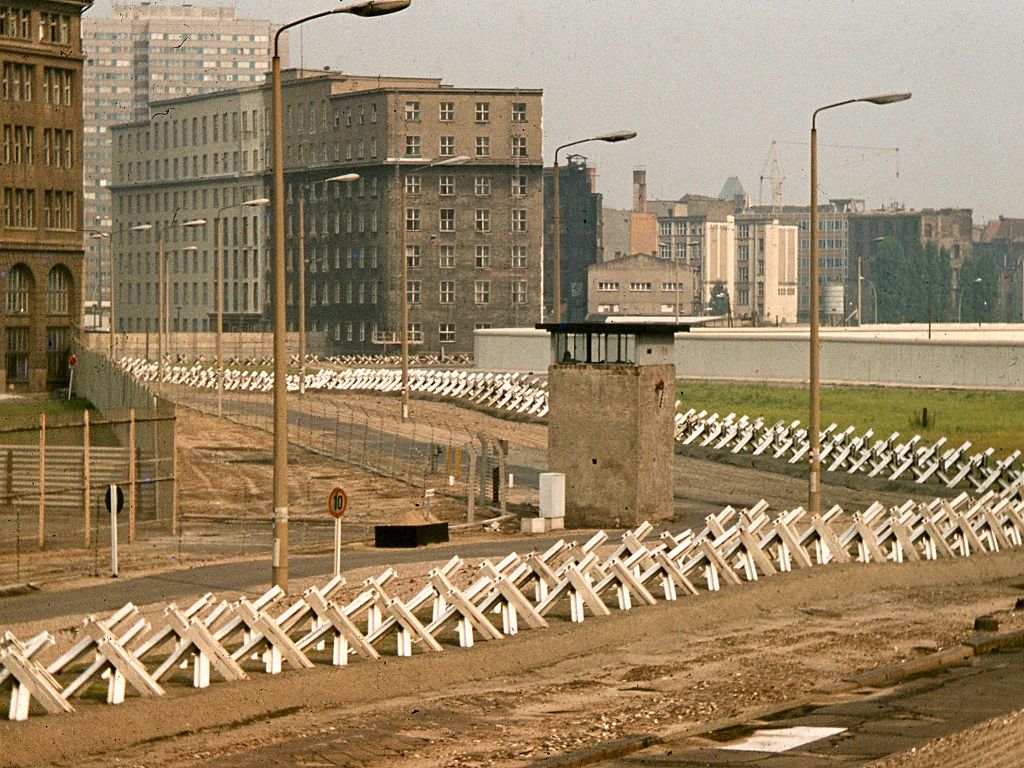
SUMMARY
BIG IDEA: The Cold War was a conflict about what was the best economic system and split the world between the Soviet Union and the United States and the allies of these two superpowers. Many of the alliances, geographic divisions, and international systems of the Cold War are the results of the way World War II ended.
The Cold War was a 50-year struggle between the United States and the Soviet Union. The two superpowers and their allies were trying to spread their ideas about the best way to run nations. The Soviet Union was the first communist nation and wanted to spread communism. The United States believed communism was wrong and wanted to promote a free market system.
Communism, which is now almost entirely gone in the world, is a system in which everyone works, and everyone shares in the wealth of the nation. The problem is that choice is taken out of the system, and therefore, incentive is also lost. People do not work hard, and the government becomes a dictatorship.
Before World War II ended, the leaders of the United States, United Kingdom and Soviet Union met multiple times to plan what the world would look like after the fighting ended.
After World War II, most of the nations in Africa and Asia that had been European colonies became independent. Many of these nations were poor, and both the United States and Soviet Union tried to win them as allies during the Cold War. Sometimes, this led to violence.
After World War I, Woodrow Wilson had tried to create a League of Nations to help prevent future war. After World War II, the United Nations was created. This time, the United States did join, and the UN has played an important role in the world as a peacekeeper and a forum for debate.
When Germany fell and the war ended in Europe, the Americans, French, British and Soviets divided up Europe into East and West. In the lands in the East that the Soviet armies had occupied, communist governments were supported. In the West, democratic governments were encouraged. This led to a division of the continent that would last throughout the Cold War. Germany itself was divided into East and West, as was Berlin, its capital city.

VOCABULARY
![]()
PEOPLE AND GROUPS
Karl Marx and Friedrich Engels: German intellectuals who promoted the ideas of socialism and communism and wrote the Communist Manifesto.
Nicolas II: The last czar, or king of Russia. He and his family were murdered by the Bolsheviks.
Vladimir Lenin: Leader of the Bolsheviks and first communist leader of the Soviet Union.
Bolsheviks: The communist revolutionaries in Russia.
Josef Stalin: One of Lenin’s supporters and the second leader of the Soviet Union from 1922-1953.
Franklin D. Roosevelt: President of the United States during the Great Depression and most of WWII.
United Nations (UN): An organization in which the nations of the world meet to cooperate and solve disputes. The headquarters is in New York City.
Security Council: The small group of nations that has the authority to set policy for the United Nations. It includes five permanent members: the US, UK, France, Russia and China.
General Assembly: The body of the representatives of every nation that is a member of the United Nations. This group can pass resolutions to express opinion but does not have the authority to set policy.
Secretary General: The administrator of the United Nations. The Secretary General traditionally plays a peace-keeping role in the world.
![]()
KEY IDEAS
Capitalism: An economic system in which people are free to make choices about how to spend money, where to work, etc.
Capital: Money
Free Market Economy: Another term for capitalism.
Communism: An economic systems in which the government controls all production and distribution. In theory, everyone works and everyone shares.
From everyone according to his ability, to everyone according to his need: A slogan that explains how a communist economy works. Everyone contributes and everyone shares in the profits.
Veto: The right to reject a law. In the case of the United Nations, each of the five permanent members of the Security Council can veto a measure.
![]()
BOOKS
The Communist Manifesto: The book by Marx and Engels that explained communism.
![]()
LOCATIONS
Union of Soviet Socialist Republics (USSR): The official name of the Soviet Union.
Israel: Nation created in the Middle East after WWII largely by Jews who escaped the Holocaust. Israel and the United States are strong allies, but Israel has a history of violent confrontation with its Arab neighbors.
Third World: The traditionally poorer regions of the world including Central and South America, Africa, the Middle East, South Asia and Southeast Asia.
Iron Curtain: The division between Eastern and Western Europe marking the separation between the communist and free worlds.
Berlin Wall: A wall built by the East German government in 1961 to prevent people from escaping to West Berlin. It became a symbol of the division between the free and communist worlds.
![]()
EVENTS
Yalta Conference: February 1945 meeting between President Roosevelt, Josef Stalin, and Great Britain’s Prime Minister Winston Churchill to make agreements about the post-WWII world.
Potsdam Conference: A conferences in July and August 1945 between President Truman, Josef Stalin and Great Britain’s Clement Attlee in which the leaders agreed to divide Germany into four zones of occupation.
Decolonization: The process by which former colonies in the Third World gained independence from European powers in the first few decades after WWII.
